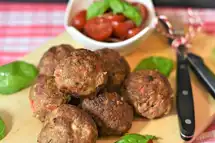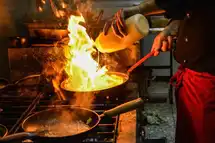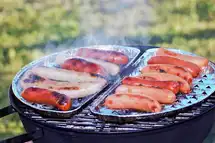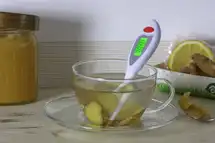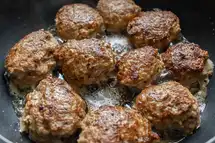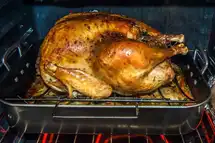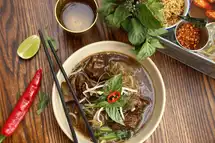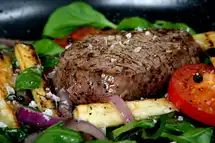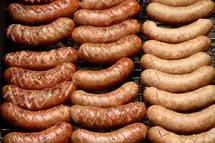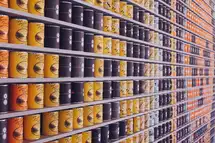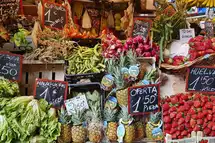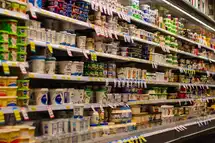What is a food safety temperature chart?
A food safety temperature chart is a guide that provides recommended temperatures for cooking different types of food. The chart typically includes information on how long to cook the food at each temperature, as well as safe storage temperatures.
How To Make Sure Your Staff Follows A Food Safety Temperature Chart
What is a Food Safety Temperature Chart?

One of the most important factors determining food safety is temperature. Cooking at temperatures too low for too long allows harmful bacteria to survive and make people sick. On the other hand, cooking above the ideal temperature limits can dry out your food, make it tasteless and unappetizing, and reduce its nutritional value.
A food safety temperature chart is a reference guide that tells you how long to cook or keep food at a given temperature to prevent foodborne illnesses. The chart shows how quickly bacteria can multiply in conditions favorable to their growth (faster growth rates indicate a greater risk for bacterial contamination in food). Therefore, keeping or cooking food at unsafe temperatures creates an environment where bacteria can rapidly multiply and potentially make people sick.
The temperature range between 40 F and 140 F is known as the Danger Zone where bacteria thrives. To reduce the risk of food getting contaminated, it is best not to leave it out for more than two hours (if exposed to temperatures above 90 F, don't let it stay out for more than an hour).
The Perils of Ignoring Safe Food Temperatures
Foodborne illness is caused by ingesting contaminated foods. It can cause severe sickness and even death. The symptoms of food poisoning include vomiting, diarrhea, abdominal pain, fever, and muscle ache. Food contamination can occur during production and processing, so it's important to follow food safety guidelines from start to finish. For example, ignoring safe cooking temperature guidelines can cause the following-
- If food is not cooked or stored at the right temperature, it can lead to food poisoning. Harmful bacteria start to grow on food not kept at a cold enough temperature. These bacteria contaminate the food and make people sick if consumed.
- If food is not held at the correct temperature, it can spoil. Spoiled food will have an unpleasant smell, taste, or appearance. It can also cause nausea, vomiting, diarrhea, and abdominal cramps.
- If food is not cooked or reheated properly, bacteria can survive in it and make people sick. Some types of bacteria can produce toxins that are not destroyed by cooking. These toxins can cause severe illness or even death.
- One of the most important points to remember is to cook meat and poultry thoroughly. Bacteria that cause food poisoning thrive in warm environments, so it's crucial to cook these items until they reach safe internal temperatures.
- While there are general guidelines for what temperatures foods should be cooked to be safe and palatable, it's important to use a reliable thermometer when checking food temperatures. This will help ensure that your food is cooked properly every time.
- Pay close attention to how long foods have been sitting out at room temperature; even if they were cooked at a safe temperature, bacteria could start to grow rapidly once food reaches room temperature.
Knowing which foods should be cooked at what temperatures can be confusing.
A food safety temperature chart will give you the correct cooking and storage temperatures for any food in your kitchen.
The Food Temperature Chart Decoded
| Food items | Storing at room temperature (50 to 70 degrees Fahrenheit) | Refrigeration (at 40 degrees Fahrenheit or below) | Freeze (at 0 degree Fahrenheit or below) | Internal temperatures while cooking (F) |
| Fresh meats- beef, lamb, veal or pork (steaks, chops or roasts) | Not safe | Three to five days | Four to twelve months | 145 Rest time- 3 minutes |
| Ground meats (beef, pork, veal, lamb, stew) | Not safe | One to two days | Three to four months | 160 |
| Bacon | Not safe | Two weeks | One month | 160 |
| Sausage or raw meat from beef or pork | Not safe | One to two days | Three to four months | 165 |
| Raw fish and shellfish | Not safe | One to two days | Three to eight months (the flavor and texture will lessen with time.) | 145 or cook until flesh is no longer translucent and separates easily with a fork |
| Cooked fish, shellfish and other seafood | Not safe | Three to four days | Three to four months | Cook until shells open during cooking |
| Canned fish (commercially), such as tuna | Not safe | If unopened, for five years or till "Use by'' date on the packet. Opened, one week. | | 145 |
| Raw eggs | One to two days | Three to five weeks | | Cook until yolk and white are firm |
| Hard boiled eggs | Not safe | One week | One to two months | 160 |
How to Make Sure Food is Cooked to the Right Temperature
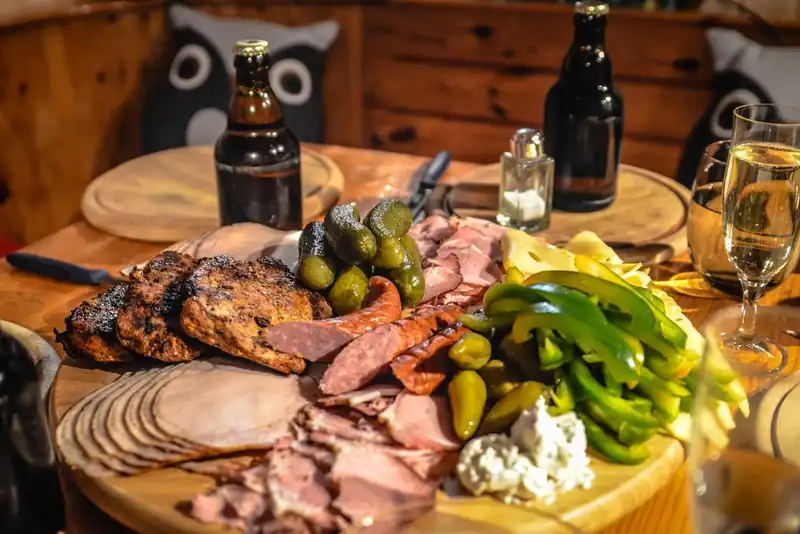
Food becomes contaminated with bacteria when it isn't cooked properly. To ensure that your food is free from harmful bacteria, it's important to use a food thermometer to check its minimum internal temperature. Sometimes, you can rely on color or texture to tell if seafood is cooked properly, but those characteristics aren't reliable indicators for all types of food.
It is always advisable to use a food thermometer to make sure that foods are cooked to a safe internal temperature. As per CDC, a pre-determined internal temperature (follow the chart above) helps ensure food safety. When cooking meat poultry and egg products, make sure that the food has reached a safe minimum internal temperature to prevent undercooking, in order to mitigate the risk of foodborne illness.
Microwave food thoroughly. Follow recommended cooking temperatures and standing times. If a microwave is used without following these directions, food may be unsafe to eat. Letting food sit for a few minutes after microwaving allows heat to be absorbed by cold spots, which cooks the food completely.
The higher the wattage of an oven, the quicker it will cook food. If you are not aware of the wattage of your oven when using cooking directions from various sources (such as cookbooks), try looking on the inside of the oven door, in the owner's manual, or on the serial number plate on the back of the oven. If your microwave is high-wattage (800 watts or more), use the minimum cooking time recommended for that type of food; use it only if necessary, unless otherwise instructed by an expert. If your microwave is low-wattage (300-500 watts), use the maximum cooking time for any foods cooked in this manner. These times are based on testing done by experts and should not be altered without instructions from a professional.
When reheating leftovers in the microwave, use a food thermometer to ensure that the cooked dish reaches 165 F before serving it hot to prevent bacterial growth.
How to Make Sure Food is Stored at the Right Temperature
It's important to remember that cooking temperature isn't the only factor in food safety. Food storage temperatures play a significant role too. This involves putting raw meats, fruits, vegetables, or seafood in airtight bags with absorbent material (napkins or paper towels) to soak up spills and prevent the juices from spoiling other items in the refrigerator. Following such practices can go a long way in preserving the freshness of food. It will help prevent bacteria from growing and reduce the risk of contamination and foodborne illnesses.
Contamination can be prevented by ensuring that all meats and seafood are wrapped tightly in cling-wrap before they are stored, packages are marked clearly and different items are stored in separate areas of your refrigerator so they don't get mixed up with other foods and spoil them. Right storage processes also reduce food waste and help ensure that leftovers don't end up in waste bins.
Here are a few things to note and follow-
- Meats and poultry products can spoil quickly and easily if not properly handled and stored. If meat products are not handled with care, they can cause several foodborne illnesses, from Bovine Spongiform Encephalitis to E. coli.
- Temperature is key in storing meat and poultry products -- too high or too low -- and bacteria will have the perfect environment to thrive, leading to foodborne illnesses. If there's a power outage, it's important to ensure that meat products are transferred to a place where the temperature will stay consistent. If food safety rules can't be followed, it's safer to throw the meat out to prevent contamination. Additionally, one should always store raw meats at a lower temperature than cooked or ready-to-eat products.
- Many believe purchasing fruits and veggies in canned, dried, or frozen form is the healthier option. However, it is wiser to go for fresh produce. Refrigerating vegetables and fruits is the best way to store them longer. It's alright for most vegetables and fruits to be stored at 40 F or below. However, fresh vegetables like onions and potatoes require slightly warmer temperatures, while items like bananas and avocados should not be refrigerated either.
- Extra water in fresh produce can spoil it quickly. To avoid this, use a crisper drawer. It allows for air to pass through the produce, preventing it from drying out, while ensuring that excess water doesn't collect. This could cause the produce to mold.
- When it comes to the safety of seafood, it begins at the market itself. It is always advisable to buy refrigerated fish, or fish stored on an ice-bed. Before buying fish, ensure it doesn't give off an ammonia-like smell; it should smell fresh with only a mild odor. Every seafood product will have a temperature/time indicator on the package. Be sure to check the label before purchasing the product. In addition, only buy products that have been certified. If you're unsure, always ask the seller about their process for storing seafood.
- Like seafood, the process for egg storage begins at the market. The pathogen Salmonella is often found on the surface of eggs. If they're not handled properly, they can become contaminated very easily. To prevent this, the United States Food and Drug Administration (FDA) has put together guidelines for storing, handling, and cooking eggs. Eggs are usually sold in sealed packages, but if the package is punctured or if the shells are cracked or dirty, it is better to discard them. Once bought, eggs should be promptly stored at 40 F or below in the refrigerator.
- Frozen or cold foods should be stored at 0 F.
The Food Safety Temperature Chart is a resource for people who want to know how to cook and store food safely.
This chart is designed to help make sure your food and the health of your customers is safe.
Advantages of Food Thermometers
Flavor, texture, and aroma are the most important factors that characterize food. However, what is equally important is its safe minimum internal temperature. This is what determines if the food you are consuming is safe to eat or not. And food thermometers are the best way to gauge this. The United States Department of Agriculture (USDA) recommends using food thermometers to ensure food safety.
Here are some of the advantages of food thermometers-
- Food thermometers eliminate guesswork and prevent under/overcooking.
- Pathogenic microorganisms are destroyed at different temperatures. The temperature for doneness for different meat and poultry products varies too. Anyone looking for a visual sign of doneness might overcook the food, but a cook using a food thermometer can check for doneness and feel assured the food has reached the minimum required cooking temperature.
- These thermometers are heat-resistant and can withstand temperatures of up to 600 F.
- Most wireless thermometers allow you to monitor your food's temperature from 150 feet away.
- Thermometers with Bluetooth probe technology are extremely accurate and provide accurate temperature readings up to +/- 2 degrees Fahrenheit or less.
- A food thermometer can also ensure that cooked food is held at safe temperatures until served.
Conclusion
As per the Centers for Disease Control (CDC), 48 million Americans -- one in six -- fall sick from foodborne pathogens each year. By cooking food at the correct temperature, you can control the levels of bacteria that spoil foods and cause illness.
Heat kills germs, and cold temperatures slow down their development, preventing them from reaching harmful levels. The internal temperature of food rises while cooking, killing pathogens associated with foodborne illnesses. For example, whole cuts of meats like lamb, beef, pork, or veal should have an internal temperature of 145 F to be safe to consume.
Regarding storage, refrigeration helps slow down the proliferation of harmful bacteria, which flourish fastest in the temperature range between 40 F and 140 F (Danger Zone). To ensure food safety, it is recommended to steer clear of this zone.
Figuring out the right temperature to cook and store food can be a challenge.
There are so many charts to follow, but which ones are right for you?






















